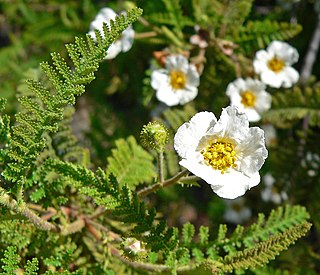
Chamaebatia, also known as mountain misery, is a genus of two species of aromatic evergreen shrubs endemic to California. Its English common name derives from early settlers' experience with the plant's dense tangle and sticky, strong-smelling resin. They are actinorhizal, non-legumes capable of nitrogen fixation through symbiosis with actinobacteria Frankia.

Bradyrhizobium is a genus of Gram-negative soil bacteria, many of which fix nitrogen. Nitrogen fixation is an important part of the nitrogen cycle. Plants cannot use atmospheric nitrogen (N2); they must use nitrogen compounds such as nitrates.
Serratia symbiotica is a species of bacteria that lives as a symbiont of aphids. In the aphid Cinara cedri, it coexists with Buchnera aphidicola, given the latter cannot produce tryptophan. It is also known to habitate in Aphis fabae. Together with other endosymbionts, it provides aphids protection against parasitoids.
Regiella insecticola is a species of bacteria, that lives as a symbiont of aphids. It shows a relationship with Photorhabdus species, together with Hamiltonella defensa. Together with other endosymbionts, it provides aphids protection against parasitoids.
Pararhizobium giardinii is a Gram negative root nodule bacteria. It forms nitrogen-fixing root nodules on legumes, being first isolated from those of Phaseolus vulgaris.
Rhizobium gallicum is a Gram-negative root-nodule bacterium. It forms nitrogen-fixing root nodules on legumes, being first isolated from those of Phaseolus vulgaris.
Bradyrhizobium arachidis is a species of legume-root nodulating, microsymbiotic nitrogen-fixing bacterium. It was first isolated from Arachis hypogaea root nodules in China. Its type strain is CCBAU 051107T.
Bradyrhizobium liaoningense is a species of legume-root nodulating, microsymbiotic nitrogen-fixing bacterium. It was first isolated from Glycine soja and Glycine max root nodules in China. Its type strain is strain 2281.
Vibrio coralliilyticus is a Gram-negative, rod-shaped bacterium. It has a polar flagellum that is used for motility and has been shown to be critical for its virulence to corals. It is a versatile pathogen, impacting several marine invertebrates including Pocillopora damicornis corals, both the Pacific and Eastern Oyster’s larvae and some vertebrates such as the rainbow trout. It is a bacterium of considerable interest given its direct contribution to temperature dependent coral bleaching as well as its impacts on aquaculture where it can contribute to significant mortalities in larval oyster hatcheries. There are several known virulent strains, which appear on both the Pacific and Atlantic Coasts of the United States. After its initial discovery some strains were incorrectly classified as Vibrio tubiashii including the RE22 and RE98 strains but were later reclassified as Vibrio coralliilyticus.
Leptospirillum ferriphilum is an iron-oxidising bacterium. It is one of the species responsible for the generation of acid mine drainage. It is of particular relevance in South African commercial biooxidation tanks operating at 40 °C.
Mesorhizobium plurifarium is a species of root nodule bacteria first isolated from Acacia species in Senegal. Its type strain is ORS 1032.
Bradyrhizobium yuanmingense is a species of legume-root nodulating, endosymbiont nitrogen-fixing bacterium, associated with Lespedeza and Vigna species. Its type strain is CCBAU 10071(T).
Bradyrhizobium iriomotense is a species of legume-root nodulating, endosymbiont nitrogen-fixing bacterium, first isolated from Entada koshunensis. The type strain is EK05T.
Pelobacter carbinolicus is a species of bacteria that ferments 2,3-butanediol and acetoin. It is Gram-negative, strictly anaerobic and non-spore-forming. Gra Bd 1 is the type strain. Its genome has been sequenced.
Bradyrhizobium betae is a species of legume-root nodulating, microsymbiotic nitrogen-fixing bacterium first isolated from the roots of Beta vulgaris, hence its name. It is slow-growing an endophytic. The type strain is PL7HG1T.
Devosia neptuniae is a nitrogen-fixing bacteria that nodulates Neptunia natans. It is Gram-negative, strictly aerobic short rod-shaped and motile by a subpolar flagellum. The type strain of D. neptuniae is LMG 21357T.
Methanoculleus submarinus is a methanogen. It is non-motile and highly irregular coccoid-shaped. Nankai-1 is its type strain.
Sodalis is a genus of bacteria within the family Pectobacteriaceae. This genus contains several insect endosymbionts and also free-living group. It is studied due to its potential use in biological control of tsetse fly. Sodalis is important model for evolutionary biologists because of its nascent endosymbiosis with insect.
Rhizobium lusitanum is a Gram negative root nodule bacteria, specifically nodulating Phaseolus vulgaris. Its type strain is P1-7T.
Chloroflexus aggregans is a thermophilic, filamentous, phototrophic bacterium that forms dense cell aggregates. Its type strain is strain MD-66.

